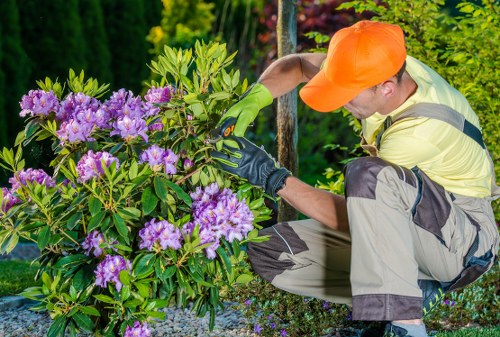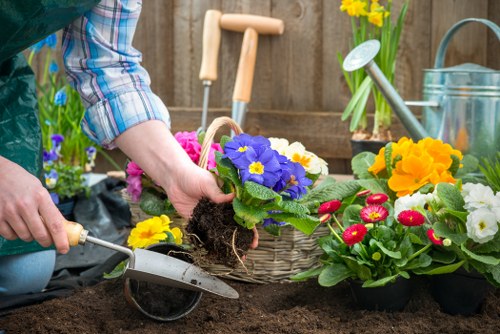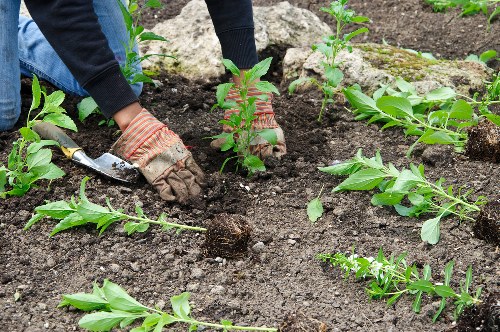Expert Hedge Trimming Services in Peckham

Maintaining well-trimmed hedges is crucial for the overall health and aesthetic appeal of your garden. In Peckham, where urban living spaces are complemented by lush greenery, hedge trimming plays a pivotal role in enhancing curb appeal and ensuring plant health.
Regular trimming helps in controlling the size and shape of your hedges, preventing them from becoming overgrown and unmanageable. It also promotes bushier growth, as cutting back encourages the plant to produce more branches.
Moreover, well-maintained hedges act as natural barriers, providing privacy and reducing noise pollution from the bustling streets of Peckham. They also serve as habitats for local wildlife, contributing to the biodiversity of the area.

The best time to trim hedges in Peckham is during the late spring or early summer months. This timing ensures that the plants have ample time to recover and produce new growth before the colder months set in.
Start by assessing the size and shape you desire for your hedges. Use sharp, clean tools to make precise cuts, avoiding damage to the plant. It's important to trim uniformly to maintain the desired shape and promote even growth.
For thicker hedges, consider using hedge shears or electric trimmers for efficiency. Always wear protective gear, such as gloves and safety glasses, to prevent injuries while trimming.

While DIY hedge trimming can save money, hiring professionals in Peckham offers several advantages. Professional trimmers have the expertise and equipment to handle various hedge types, ensuring precise and clean cuts that enhance the hedge's appearance.
Experienced trimmers can identify and address potential issues such as disease or pest infestations during the trimming process. This proactive approach helps in maintaining the long-term health of your hedges.
Additionally, professional services save you time and effort, allowing you to focus on other aspects of garden maintenance or personal activities.

When selecting a hedge trimming service, consider factors such as experience, reputation, and customer reviews. A reputable service provider will offer transparent pricing and guarantee satisfaction with their work.
Look for companies that use eco-friendly practices, such as recycling green waste and using sustainable materials. This not only benefits the environment but also reflects the company's commitment to responsible gardening.
Request quotes from multiple providers to compare services and prices. Ensure that the service you choose aligns with your specific hedge trimming needs and garden aesthetics.

If you prefer to trim your hedges yourself, follow these essential tips for optimal results. Begin by gathering the right tools, including hedge shears, loppers, and a sturdy ladder for taller hedges.
Start by removing any dead or diseased branches to promote healthy growth. Then, shape the hedge by trimming the sides and top evenly, maintaining a consistent form.
Regular maintenance, such as trimming every few months, prevents excessive growth and makes the task more manageable. Always prioritize safety by using proper techniques and protective gear.
Common Hedge Trimming Mistakes to Avoid
Even with the best intentions, certain mistakes can compromise the health and appearance of your hedges. Avoid over-trimming, as cutting too much can stress the plant and hinder growth.
Steer clear of using dull tools, which can cause ragged cuts and increase the risk of disease. Regularly sharpen and maintain your trimming equipment to ensure clean and precise cuts.
Finally, neglecting to plan your trimming strategy can lead to uneven shapes and misshapen hedges. Take the time to outline your desired form before you begin, ensuring a uniform and attractive finish.
Advanced Hedge Trimming Techniques
For those looking to elevate their hedge trimming skills, consider incorporating advanced techniques. These methods not only improve the visual appeal of your hedges but also promote healthier plant growth.
Topiary Trimming
Topiary involves shaping hedges into artistic forms, such as animals, geometric shapes, or intricate patterns. This technique requires precision and patience but can transform your garden into a visually stunning space.
Thinning Cuts
Thinning cuts involve selectively removing branches to reduce density and improve air circulation within the hedge. This practice helps prevent disease and promotes robust growth by allowing light to penetrate the foliage.
Heading Cuts
Heading cuts focus on shortening the length of branches to encourage lateral growth. This method is effective for maintaining a compact and bushy appearance in your hedges.
Tools for Advanced Trimming
- Professional hedge shears
- Electric trimmers
- Pruning saws
- Ladders and scaffolding
- Protective gear
Eco-Friendly Hedge Trimming Practices
Adopting eco-friendly practices in hedge trimming not only benefits the environment but also enhances the sustainability of your garden. Start by using manual tools or electric trimmers to reduce carbon emissions associated with gas-powered equipment.
Compost the green waste generated from trimming to create nutrient-rich soil for your garden. This practice minimizes landfill waste and recycles natural resources effectively.
Additionally, choose native hedge species that are well-suited to Peckham’s climate, requiring less water and maintenance while supporting local wildlife.
Integrated Pest Management
Implement integrated pest management (IPM) strategies to keep your hedges healthy without relying on harmful chemicals. IPM focuses on natural pest control methods, such as introducing beneficial insects and using organic treatments.
Beneficial Insects
Encourage the presence of beneficial insects like ladybugs and lacewings, which prey on common hedge pests. Planting nectar-rich flowers nearby can attract these natural predators, maintaining a balanced ecosystem in your garden.
Organic Treatments
Use organic pesticides and treatments to address pest issues. These alternatives are less harmful to the environment and safer for both humans and wildlife.
Regular Monitoring
Consistently monitor your hedges for signs of pests or diseases. Early detection allows for timely intervention, preventing minor issues from escalating into major problems.
Seasonal Hedge Trimming in Peckham
Understanding the seasonal requirements of your hedges ensures year-round health and beauty. Each season presents unique challenges and opportunities for hedge maintenance.
Spring Trimming
In spring, focus on rejuvenating your hedges by removing deadwood and promoting new growth. This is also the ideal time for applying fertilizers to support healthy development.
Summer Trimming
Summer trimming involves shaping and reducing the size of your hedges to prevent excessive growth and maintain their form. Ensure adequate watering during this period to support the plants' needs.
Autumn Trimming
Autumn is the time to prepare your hedges for the winter months. Trim back any overgrown branches and clear away fallen leaves to reduce the risk of disease and pest infestations.
Winter Trimming
While winter is generally a quiet period for hedge trimming, inspect your hedges for any weather-related damage and make necessary repairs. Protect vulnerable branches with frost-resistant materials to ensure their survival through the colder months.
Cost of Hedge Trimming Services in Peckham
The cost of hedge trimming in Peckham varies based on factors such as the size and type of hedges, accessibility, and the complexity of the trimming required. On average, professional services may range from £50 to £150 per session.
- Small Hedges: £50 - £80
- Medium Hedges: £80 - £120
- Large or Complex Hedges: £120 - £150+
Additional costs may apply for specialized services, such as topiary or eco-friendly trimming practices. Always request a detailed quote to understand the pricing structure and any potential extra fees.
Factors Influencing the Cost
- Hedge Size: Larger hedges require more time and resources, increasing the overall cost.
- Accessibility: Hedges in hard-to-reach areas may necessitate additional equipment, such as scaffolding, affecting the price.
- Complexity: Intricate trimming designs or specialized services add to the cost of the service.
- Frequency: Regular maintenance contracts may offer discounted rates compared to one-time services.
Maintaining Your Hedges Between Professional Trimmings
To keep your hedges in pristine condition between professional trimmings, follow these maintenance tips. Regularly inspect your hedges for any signs of overgrowth, pests, or diseases.
Light pruning between major trimming sessions helps in maintaining the shape and health of your hedges. Use hand shears for minor adjustments and to address specific areas that require attention.
Ensure that your hedges receive adequate water and nutrients, especially during dry spells. Mulching around the base of the hedges can help retain moisture and suppress weed growth.
Proper Watering Techniques
Water your hedges deeply but infrequently to encourage deep root growth. Avoid shallow watering, which can lead to weak roots and increased susceptibility to drought.
Mulching Benefits
Mulching not only conserves moisture but also improves soil structure and provides essential nutrients as it breaks down. Apply a layer of organic mulch around the base of your hedges, keeping it away from direct contact with the stems to prevent rot.
Weed Control
Regularly remove weeds from around your hedges to reduce competition for nutrients and water. Weeds can also harbor pests and diseases that may affect your hedges.
Enhancing Hedge Health with Proper Nutrition
Proper nutrition is vital for the health and growth of your hedges. Fertilizing your hedges at the right time ensures they receive the necessary nutrients to thrive.
- Nitrogen: Promotes leafy growth and overall vigor.
- Phosphorus: Supports root development and flower production.
- Potassium: Enhances disease resistance and stress tolerance.
Use a balanced fertilizer or one tailored to the specific needs of your hedge species. Always follow the manufacturer's instructions to avoid over-fertilization, which can damage the plants.
Organic vs. Synthetic Fertilizers
Organic fertilizers, such as compost or well-rotted manure, improve soil structure and provide a slow release of nutrients. They are environmentally friendly and beneficial for long-term soil health.
Synthetic fertilizers offer immediate nutrient availability but can lead to nutrient runoff and potential soil imbalances if not used properly. Choose the type that best aligns with your gardening practices and environmental considerations.
Final Thoughts on Hedge Trimming in Peckham
Hedge trimming is an essential aspect of garden maintenance in Peckham, contributing to the health, beauty, and functionality of your outdoor space. Whether you choose to hire professionals or undertake the task yourself, regular trimming ensures your hedges remain attractive and thriving.
Investing time and resources into proper hedge care not only enhances your property's curb appeal but also fosters a sustainable and vibrant garden environment. Embrace the benefits of well-maintained hedges and enjoy the verdant beauty they bring to your Peckham home.
Contact us today to book your hedge trimming service and give your garden the care it deserves!

